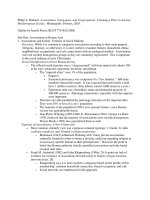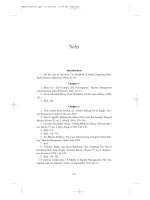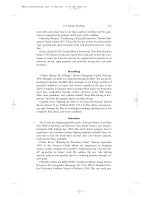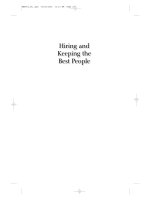Tài liệu Hiring and Performance Appraisal of the Executive Director ppt
Bạn đang xem bản rút gọn của tài liệu. Xem và tải ngay bản đầy đủ của tài liệu tại đây (628.34 KB, 74 trang )
Hiring and Performance Appraisal
of the Executive Director
B oa r d d e v e lo p m e n t
Hiring and Performance Appraisal
of the Executive Director
A Self-Guided Workbook
The Right to Copy this Workbook
Permission is given to any not-for-profit organization to photocopy any or all of this workbook for use within their
organization, provided credit is given to the source.
An Important Note Before You Get Started
Not-for-profit organizations vary considerably in their make-up, their objectives, and their methods of operation.
The information in this workbook is written generally, and may not exactly fit the needs of your organization. It is
meant to be a starting point for you to deal with some of the issues that face many not-for-profit organizations.
The publisher does not give legal or other professional advice. Therefore, if you are doubtful about acting on any
information in this workbook or want clarification, you may wish to seek professional advice to make sure that it
answers your concerns and issues.
The Muttart Foundation and the Government of Alberta are not liable if you use any of the contents of this workbook.
Make sure that you have the benefit of professional advice that relates directly to your organization.
© The Muttart Foundation and Alberta Culture and Community Spirit
ISBN 0-9697939-7-9
Printed in Canada
First Printing 1998
Revised Edition 2003
Revised Edition 2008
Published by:
The Muttart Foundation
1150 Scotia Place
10060 Jasper Avenue
Edmonton, Alberta T5J 3R8
Phone: (780) 425-9616
FAX: (780) 425-0282
Alberta Culture and Community Spirit
Board Development Program
907, 10405 Jasper Avenue
Edmonton, Alberta T5J 4R7
Phone: (780) 427-2001
FAX: (780) 427-4155
Acknowledgements
This workbook was developed by the Board Development Program of Alberta Culture and Community Spirit in
collaboration with The Muttart Foundation. The contributions of all those involved in the Board Development Program,
including Grant MacEwan College, the Wild Rose Foundation, and the volunteer instructors who deliver the program to
not-for-profit agencies across Alberta, are also acknowledged.
Hiring and appraising the executive
director of a not-for-profit organization
are big jobs. Many competent and
effective boards approach these jobs
with a sense of fear and trepidation.
They know the choice of an executive
director has far-reaching consequences
for the health, viability, and future of
the organization, so it is important to
select the most appropriate person.
As well, they know that sound
management of the performance of
the executive director is essential for
making sure that the organization is
meeting the goals that the board has set.
This workbook is designed as a
guide for boards of directors who
are in the process of hiring a new
executive director and/or providing
the executive director with a
performance appraisal. The workbook
is divided into four parts:
• TheOrganization’sFoundations
• TheExecutiveDirector’sMandate
• TheHiringProcess
• ThePerformanceAppraisal
Process
Chapter I:TheOrganization’s
Foundations examines the role,
responsibilities, and functions of a
governing board, as well as board
and staff relations. Chapter I includes
a review of the considerations of a
governing board before starting
the process of either hiring a new
executive director, or conducting
a performance appraisal with the
executive director.
Chapter II: The Executive
Director’sMandateexaminesthe
role, responsibilities, and functions
of an executive director. Chapter II
provides a sample job description that
lists key responsibilities, including
policy management, program
management, financial management,
personnel management, and advocacy
management. For arts organizations,
there is a section on the role of
the artistic director.
Chapter III: The Hiring Process
focuses on the hiring process in a
step-by-step manner, with supporting
material, such as a sample candidate
rating sheet, and sample interview
questions that can be modified
for your organization.
Chapter IV: The Performance
Appraisal Process focuses on the
performance appraisal process in a
step-by-step manner. Whether you
are providing a probation period
performance appraisal for the new
executive director, or whether the
executive director has never had an
appraisal, this process will help you
to get started right away.
In addition to using this workbook,
you may also want to consult other
not-for-profit organizations to share
information and materials that
can help you to accomplish these
important tasks. Perhaps an
organization similar to yours has
recently hired an executive director,
or has experience in conducting
successful performance appraisals
with the executive director. Board
members are usually willing to pass
along their tips for success, as well as
information about potential pitfalls.
7
The Organization’s
Foundations
The Governing Board
of a Not-for-Profit
Organization 7
Strengthen Your
Foundations 10
Board and
Staff Relations 12
Summary 15
16
The Executive
Director’s Mandate
The Executive
Director’sJobDescription 16
Key Responsibilities 17
The Artistic Director in
CulturalOrganizations 21
Summary 21
22
The Steps to
the Hiring Process
Step 1: Is your
HouseinOrder? 22
Step 2: Review the
ExecutiveDirector’s
Mandate 22
Step 3: Assign
Responsibility for
the Hiring Process 23
Step 4: Identify
Strategic Challenges 24
Step 5: Set Time
Lines for the Process 25
Step 6: Conduct
Pre-Interview Activities 25
Step 7: Advertise
the Position 28
Step 8: Select Candidates
for Interviews 29
Step 9: Interview the
Candidates 30
Step 10: Make the
JobOffer 31
Step 11: Welcome
Your New Executive
Director 32
Summary 33
34
The Performance
Appraisal Process
Why is a Performance
AppraisalImportant? 34
The Steps to the
Performance Appraisal
Process 38
Step 1: Is Your House
inOrder? 38
Step 2: Review the
ExecutiveDirector’s
Mandate 38
Step 3: Assign
Responsibility for
the Performance
Appraisal Process 39
Step 4: Gather
Documentation 40
Step 5: Set Meeting
Dates and Agendas 42
Step6:CarryOutthe
Performance Appraisal
Process 45
Step 7: Conduct a
Committee Self-Evaluation 46
Summary 46
47
1. Does Your
OrganizationNeedan
ExecutiveDirector? 48
2. Strategic
Planning process 49
3. Executive Director
Job Description 51
4. Sample Candidate
Rating Sheet 54
5. Sample Interview
Questions 57
6. Alberta Human
Rights and Citizenship
Commission: A
recommended Guide
for Pre-Employment
Inquiries 58
7. Alberta Human
Rights and Citizenship
Commission: Pre-
Employment Inquiries 60
8. Appraisal
Reporting Form 64
9. Sample
Appraisal Policy 65
10. Performance
Appraisal Checklist 66
67
69
When a board is faced with hiring a
new executive director, or conducting
a performance appraisal with the
executive director, it is important to
remember that these are processes,
rather than single events, for the
organization. When the executive
director leaves the organization, the
board has an opportunity to take a
fresh look at the entire organization.
There are many things that a
board needs to consider before
beginning either the hiring process
or the performance appraisal process.
Chapter I will help you to review the
structure of your organization, and to
identifytheexecutivedirector’srole.
InChapterI,theword‘you’means
the board as a whole.
Not-for-profit organizations provide
programs and/or services that address
specific needs in the community.
These organizations are governed
by volunteer boards of directors,
with specific roles, responsibilities,
and functions.
The governing board is the entity
that has legal authority for the
organization, and that is responsible
fortheorganization’shighestlevel
of decision-making. The governing
board has, by law, the ultimate
accountability for, and authority
over,theorganization’sresources
and activities. The board determines
andcommunicatestheorganization’s
vision to the membership and to
the community. Through policy,
the board defines the parameters
of the organization.
A governing board has the ultimate
responsibilityfortheorganization’s:
• Purpose: establishing the
organization’spurpose
or mission
• Continuity: providing continuity
for the management and
the implementation of the
organization’saffairs
• Progress: setting the rate of
progress that the organization
takes in reaching its mission
• Identity: securing community
support and appreciation for the
organization’spurposeandlong-
term direction
The board carries out its governance
function by developing and
monitoring policy. There are four
governance functions for which the
board develops policy:
• Framework governance:
determines organizational values
through mission, vision, target,
and aim policies
• Board self-governance: establishes
how the board will organize itself
to get its work done
• Operational governance:
- Program governance: monitors
the results of program policy
- Personnel governance: defines
the relationship between the
board and the staff (for boards
with an executive director)
- Financial governance: sets
policies for budgeting and
financial reporting
• Advocacy governance:
secures community support for
the organization
The board carries out its
responsibilities by directing,
influencing, and monitoring
the implementation of the
four governance functions.
The board:
• Meetsitsresponsibilityforpurpose
through its framework governance
function
• Meetsitsresponsibilityfor
continuity through its board
self-governance function
• Meetsitsresponsibilityforprogress
through its operational governance
function (program, personnel,
finance)
• Meetsitsresponsibilityforidentity
through its advocacy governance
function
Is your organization hiring an
executivedirectorforthefirsttime?
Is your organization replacing an
executivedirector?Inordertodecide
whether or not your organization
needs an executive director, you need
to examine the type of board that your
organization has.
There are two types of governing
boards: policy governing boards
and administrative governing
boards. Both board structures are
entirely appropriate for not-for-profit
organizations, and both structures
can operate very effectively. Many
organizations begin as administrative
governing boards, with board
members doing all of the work of
the organization. As organizations
grow, the board often finds that it is
necessary to hire an executive director
to manage the day-to-day affairs.
Policy Governing Boards and
Administrative Governing Boards
• Thepolicygoverningboard
hires an executive director
to implement policy.
• Theadministrative
governing board assigns the
implementation of policies to
a board committee, such as the
executive committee or a standing
committee.Theremaybestaff
in an administrative governing
board situation, but the staff do
not manage the organization.
Policy Governing Board
• Responsiblefor
governance functions
• Setspolicyformanagement,
and delegates the responsibility
for management to the
executive director
• Executivedirectorisresponsible
for managing the implementation
of the policy.
Appendix Item #1
Administrative
Governing Board
• Responsiblefor
governance functions
• Setspolicyformanagement,
and assigns board committee(s)
to carry out the management
responsibility
• Boardcommitteemembersare
responsible for managing the
implementation of the policy
The boards of many organizations
find themselves in transition between
the two types of governing boards.
These boards must decide whether
or not they need an executive director.
Perhaps your organization is hiring
its first executive director, or your
organization no longer needs an
executive director. Before proceeding
with the hiring process for an
executive director, consider the
following questions:
• Whatistheroleofanexecutive
directorwithinyourorganization?
• Hasyourorganizationchanged
in revenue, and/or size and
complexity of programs, to warrant
achange?
• Doesyourboardofdirectorshave
the resources, and a system for the
recruitment of board members, to
managetheaddedresponsibilities?
• Couldtheboardofdirectors
carry out the executive duties on a
regularandlong-termbasis?
Taking the time to answer these
questions can be very helpful for your
organization. You may find that you
will begin to alter the structure of
your organization to better meet your
changedcircumstances.Or,youmany
find that you have done some of the
groundwork to begin the process of
hiring a new executive director.
Hiring a new executive director is
one of the most important tasks that
a board can carry out. Before you
move into the future, it is important
to take stock of the current status of
your organization. To attract the best
possible candidates for the position
of executive director, you need to
makesurethatyourorganization’s
foundations are solid. Does your
organization have:
• Up-to-datemissionand
visionstatements?
• Policiesthataddresspersonnel,
program,andfinancialconcerns?
• Aplanofactionthattakesthe
organizationintothefuture?
As a board, take the time to
strengthenyourorganization’s
foundations. Consider the following
aspects of your organization:
• Visionstatement
• Missionstatement
• Communitycommunication
• Structuralframework
• Strategicplanning
• Blockstorecruitment
go to
The vision statement represents the
core value that your organization
is working to achieve. Does your
vision statement describe what would
happen if your organizational
valuesweretocometrue?Your
vision statement describes how the
community will be different as a
resultofyourorganization’sexistence.
It describes the way things could be in
an ideal world.
Example of a Vision
Statement
We see the potential, through improved
education and informed support, to
eliminate the limitations placed on
carpal tunnel syndrome sufferers by
society, and to encourage society’s
support for sufferers, their families,
and caregivers.
Your mission statement should define
yourorganization’spurposebystating
the changes that the organization
will work to bring about. Does
your mission statement answer
the questions:
• Whydoesourorganizationexist?
• Howisourorganizationunique
fromothersinthecommunity?
• Howisourmissionstatement
valuedinthecommunity?
Example of a
Mission Statement
Fostering a climate of mutual respect,
an appreciation for diversity, and a
sense of belonging in the community,
Green Bay Youth Action Society seeks
to provide healthy alternatives for
youth activities in an environment
supportive of youth development.
Whatisyourorganization’strack
record for meeting community needs
effectivelyandefficiently?Whatkind
of reputation does your organization
haveinthecommunity?Haveyou
prepared a communication plan that
keeps your membership and the
community up-to-date with your
strategicplan?
What kind of structural framework
is in place for the operation of your
boardandyourorganization?For
example, does your organization
have up-to-date bylaw, policies,
job descriptions, and strategic
planningdocuments?
Appendix #2
Have you taken the time to
develop broad strategic goals for your
organization, based on your mission
andvisionstatements?Ifyouwant
your new executive director to lead
the organization, then the board
needs to set the direction for the
organization. Most organizations
will identify some areas that need
more work. An informal review of
your organization will help you, as
a board, to have an up-to-date view
ofyourorganization’sneeds,aswell
as the skills that your new executive
director must have to assist you
with the work.
Have you considered, and dealt with,
any reasons that a person may not
want the position of executive director
inyourorganization?Forexample,
haveyouassessedyourorganization’s
communityimage?Areyour
expectations of the executive director
toohigh?Isthesalarycompatible
withtheexpectationsoftheposition?
Do your organization and board have
a positive reputation for treating your
executivedirectorwell?Doyouhave
a method to get fair, but realistic,
answerstothesequestions?
A strong and positive relationship
between the board and the executive
director is a critical part of a healthy
organization. Having clarity in the
roles, responsibilities, and xpectations
of both the board and the executive
director helps to build the working
relationship on a strong base of
understanding. Writing down
these roles, responsibilities, and
expectations is the starting point
from which grows the executive
director’splanofaction.
What are the differences between the
boardandtheexecutivedirector?A
cleardefinitionofboththeboard’s
roleandtheexecutivedirector’srole
is an important part of positive board
and staff relations. Consider the
differences between the executive
director and the board, as listed
in the chart on the next page.
Example of
Leadership Roles
The board approves the budget,
including the total amount for staff
salaries. The executive director has
the authority to increase staff salaries,
provided that the increases do not
exceed the budgeted amount.
The executive director has the
responsibility to make sure that
the salary increases meet the
organization’spersonnel
policy guidelines.
go to
What Do You Say?
It is the blending of the roles of
the board and the executive director
that moves the organization towards
its missions and vision. When the
differences in the roles of the two are
clearly understood, the organization
can harness all of its power to work
towards the mission.
The board and the executive director
have different roles to play within the
organization. Based on these roles,
the board and the executive director
hold a number of expectations of
each other. These expectations exist,
whether or not they are discussed or
written down. Positive board and staff
relations result when these mutually-
held expectations are written down,
and reviewed from time to time.
By spelling out the expectations
from both sides, you can avoid
misunderstandings that may hinder
the work of your organization.
important
Executive Director
Management and Implementation
Board
Governance
• Theexecutivedirectorisan
individual who works within the
limits of policy set by the board.
• Theboardisacorporateentity,
and acts only as a group.
• Theexecutivedirectoristemporary.
Even if the executive director is with
the organization for a long time, s/he
is there at the will of the board.
• Theboardisongoing.Although
board members come and go, the
board as an entity remains stable.
• Theexecutivedirectorisusually
a professional who has expertise
intheorganization’sprograms
and services.
• Theboardisusuallymadeupof
lay people, many of whom are
notexpertsintheorganization’s
programs and services.
• Theexecutivedirectorhaslimited
authority and responsibility, as
assigned by the board.
• Theboardhastheultimate
responsibility for the organization,
and is the final authority on
all matters.
The board assigns some of
its executive authority and
responsibilities to the executive
director. The board may expect
the executive director to:
• Serveasthechiefexecutiveofficer
of the organization
• Managetheday-to-dayoperations
of the organization
• Serveasaprofessionaladvisorto
the board
• Recommendappropriatepolicy
issuesfortheboard’sattention
• Implementallpoliciesadoptedby
the board
• Recruit,supervise,anddevelop
competent staff, and release
incompetent staff
• Assisttheboardindevelopingand
conducting advocacy programs
The executive director has
expectationsregardingtheboard’s
activities. For example, s/he may
expect the board to:
• Developpoliciesthatgovernthe
direction of the organization
• Consultwith,andadvisethe
executive director, thus giving the
benefitoftheboard’sjudgment,
expertise, and familiarity with the
community
• Delegateresponsibilityand
authority for management
functions to the executive director
• Refrainfromhandling
management and administrative
details
• Consultwiththeexecutive
director on matters that the
board is considering
• Maketheexecutivedirector
responsible for supervising
all staff
• Providesupporttotheexecutive
director in carrying out his/her
professional duty
• Supporttheexecutivedirectorin
all decisions and actions, consistent
with the policies of the board and
the standards of the organization
• Holdtheexecutivedirector
accountable for the performance of
the organization
• Providetimelyandappropriate
performance appraisals for the
executive director
Whether you are preparing to hire
a new executive director, or to
provide the current executive director
with a performance appraisal, it is
important to take the time to put the
organizational house in order. This
preparation includes having a clear
mission, vision, and strategic plan.
Clearly define the role, responsibilities,
and expectations of both the board
of directors and the executive director.
This information forms the basis of
the job description, which is one of
the tools that you will need for either
the executive director search or the
performance appraisal process.
summary
Appendix #3
Put very simply, the executive
director carries out the work of the
organization. However, that statement
can be interpreted in many different
ways. As a board, you need to be
clear about what it is that you expect
the executive director to do in your
organization. Creating a full and
accurate job description for your
executive director is a crucial task
for both the hiring process and the
performance appraisal process. In
ChapterII,theword‘you’means
the board as a whole.
The job description of the executive
director is based on the mission,
vision, and strategic plan of the
organization. The job description
clearly identifies the roles,
responsibilities, and expectations of
the position. As well, there is a clear
linkbetweentheexecutivedirector’s
responsibilities and the policies of
the organization. The executive
director carries out the activities that
are mandated by the policy that the
board sets. Chapter I of this workbook
provides you with information on the
linksbetweentheexecutivedirector’s
workandtheboard’swork.
When you create the job description
for your executive director, be sure to
include the following information:
• Reportingtotheboard
of directors
• Areasofauthority
• Summaryofresponsibilities
• Keyresponsibilities
go to
The board appoints one individual,
usually the chairperson of the board,
tobethecommunicatoroftheboard’s
directions to the executive director.
There is more clarity, and less chance
of misunderstanding, when the
executive director takes direction
from one person, rather than from
a committee or the entire board.
Worthy of Note
Individual board members of a
policy governing board do not have
the authority to give direction to
the executive director.
The executive director holds a
key leadership position in the
organization.Undertheauthority
of the board, the executive director
assumes complete responsibility for
carrying out assigned policies and
regulations. The executive director
has the authority to direct the
implementationoftheorganization’s
programs and services, and is
responsible for the management
of all staff members and volunteers.
Theexecutivedirector:
• Directstheday-to-dayoperations
• Implementspolicy
• Hires,trains,delegates,supervises,
evaluates, and releases staff
• Attendsallboardmeetings,andis
invited to all committee meetings
• Actsasaconsultanttotheboard
and its committees
Ex Officio Status
The executive director is ex officio at
all meetings, which means that s/he
attends by virtue of his/her position.
The executive director attends the
meetings, participates, and receives
reports, but has no vote.
Itistheboard’sresponsibilitytomake
surethattheexecutivedirector’sjob
description is up-to-date, and that it
reflects the key responsibilities of the
executive director during the appraisal
period. These key responsibilities are
based on both the strategic plan, and
on what the executive director does
to manage the organization on a day-
to-day basis. If your board changes
its strategic plan, that may cause
changes to the key responsibilities
of the executive director for the next
appraisal period. In this case, you may
also need to adjust the job description.
There are ten key responsibility
areas for an executive director. You
will want to customize this list to
reflect the strategic plan of your
organization. The key areas are:
1. Policy Management
2 Strategic Planning
3. Visioning
4. Leadership
5. Program Management
6. Personnel Management
7. Financial Management
8. Risk Analysis
9. Advocacy Management
10.ExecutiveDirector’sPerformance
Appraisal Process
1. Policy Management
The executive director:
• Administerstheday-to-day
operations of the organization
• Directsthestaff ’simplementation
of policy
• Preparesprocedurestatementsfor
board policies
• Supportsboardcommitteesas
needed, while refraining from
doing the work of the committees
2. Strategic Planning
The executive director:
• Conductsbothaninternal
and external environmental
scan to identify emerging that
issues affect the organization.
The internal scan brings to the
board’sattentionissuesarising
from within the organization,
such as the increased need for
technological resources. The
external scan identifies issues
that may have an impact on the
organization, such as a change in
provincial funding policies.
• Setsspecificorganizational
goals and outcomes, under the
direction of the board of directors
• Setsgoalsformanagement
practices
• Setsprogramandservicegoals
• Identifiestherequiredresourcesto
achieve the goals
• Communicateswithkey
stakeholders to identify the
changing needs and conditions
of the community that is served
by the organization
• Considerstheimpactofseveral
alternative plans to address the
changing conditions
3. Visioning
In cooperation with the board of
directors, the executive director:
• Participatesinthecreationofan
organizational vision
• Developsprogramsandservices
that work towards the vision,
within the policy guidelines set
by the board
4. Leadership
The executive director:
• Worksincollaborationwith
staff, and relevant community
agencies and groups, to
accomplish objectives and to fulfill
responsibilities
• Encouragesteam-buildingby
facilitating open communication
and positive working relationships
with staff
• Establishescontrolandfollow-up
mechanisms for the organization
5. Program Management
The executive director:
• Facilitatestheresearch,planning,
development, implementation,
and evaluation of programs
and services
• Makessurethatprogramsand
servicesmeettheboard’spolicy
guidelines,andreflecttheboard’s
priorities
• Supervisestheimplementation
oftheorganization’sprograms
and services
6. Personnel Management
The executive director:
• Interpretsboardpolicydecisions
to staff
• Hires,supervises,evaluates,
and releases staff
• Trainsandmotivatesstaff
• Setsclear,results-orientedgoals,
with realistic and measurable
outcomes
• Supportsgoalachievement,and
coaches and monitors performance
• Assistsindividualsindeveloping
the necessary skills to be successful
within the organization
• Supportsandencourages
staff initiatives
• Observesandevaluates
ongoing performances
• Providesregular,appropriate,and
constructive feedback
• Supervisestherecruitment,
selection, orientation, and training
of service volunteers
• Assiststhepersonnelcommittee
7. Financial management
The executive director:
• Implementstheboard’spoliciesfor
the allocation and distribution of
resources
• Maintainssoundbookkeeping
procedures
• Providestheboardwithregular
statements of revenues and
expenditures
• Administersthefundsofthe
organization, according to the
budget approved by the board
• Advisesthefinancecommittee
8. Risk Analysis
To keep the board informed about the
organization, the executive director:
• Evaluates,inbroad-basedterms,
the potential assets and liabilities
of a project, proposal, or strategy
• Makessurethatbothrisksand
opportunities have been identified
and evaluated
• Assessespotentialthreatstothe
organization’simage
• Assessesriskstotheorganization’s
financial security and growth
• Providesregular,reliable,and
comparable reports on the
organization’sprogress
9. Advocacy Management
The executive director:
• Promotescommunityawareness
oftheorganization’smission
and aims
• Participatesinnetworkingand
community relations activities on
behalf of the organization
• Buildsstrongworkingrelationships
with others,
both inside and outside the
organization, and enlists their
support for accomplishing tasks
• Assiststheadvocacycommitteein
preparing an advocacy program,
and acts as an advocate for the
organization and its programs in
the community
• Workswithkeyexternal
stakeholder groups
• Identifiesandresearchesfunding
opportunities
• Facilitatesacommunicationplan
that informs the community of
the activities and direction of the
organization
• Seekspublicspeaking
opportunities
• Supervisesthemembership
recruitment campaign
10. Executive Director’s
Performance Appraisal
Process
The executive director:
• Cooperateswith,andparticipates
in, the performance appraisal
process
• Assistsintheassessment
of outcomes
• Recommendschange
when necessary
• Informstheboardofdirectors
about situations that affect the
executivedirector’sabilityto
meet his/her goals.
Anonymous
A unique characteristic of cultural
organizations is that they are often
based on the artistic vision of a
single individual. This artistic
vision becomes the central focus
of the organization. As a result, the
board of a cultural organization has
two executive directors: the artistic
director and the general manager. The
artistic director has sole responsibility
for the artistic content and the artistic
vision, and the general manager
is responsible for the day-to-day
management of the company.
Both positions report to the
board of directors through the
board-appointed designate.
If yours is a cultural organization,
you need to spell out the relationship
between the general manager and the
artistic director. Be sure to define
the authority, responsibilities, lines
of communication, and expectations
for each position. Establish a process
to deal with potential conflicts
or misunderstandings before any
problems arise.
Having a clear and accurate job
description for your executive director
is an important step in both the hiring
process and the performance appraisal
process. By spending time to be
specificabouttheboard’sexpectations
of the executive director, you will be
able to select the candidate who can
do the best job for your organization.
When you sit down with your
executive director to do a performance
appraisal, both of you will have a solid
basis for a discussion of achievements,
as well as a guide to identifying areas
for improvement.
summary
Chapter I:
Chapter II:
There are a number of tasks facing
a board when it decides to begin a
hiring process for an executive director.
The board needs to have a process that
will result in hiring the best candidate
for the organization. If there is a
personnel management specialist on
your board, s/he can provide guidance
for the hiring process.
This step-by-step guide will help you
to organize your search and hiring
process. Consider each step, and
tailor the information to work for
your organization. In Chapter III,
the words you and committee
mean the search committee.
The first step in this process is making
sure that the organizational house is
in order. You can do this by working
through Chapter I of this workbook.
If you are hiring an executive
director for the first time, you have
probably worked through Chapter
II of this workbook to develop a job
description. If you are replacing an
executive director who was with the
organization for a period of time, you
will need to review the job description
to make sure that it reflects the
current needs of the organization.
You will want to have an accurate,
up-to-date job description before
you begin the hiring process.
go to
The Search Committee
Many boards strike an ad hoc search
committee to lead the hiring process.
This committee is made up of board
members, but may also include an
outside member. Keep the committee
size small enough to facilitate an
easier and faster decision-making
process, but large enough to cover
all of the necessary skill areas.
Identify people who are willing to
commit to the entire process, and
who will provide support for the new
executive director as s/he assumes the
responsibilities. You need people with
personnel skills, knowledge about
the organization, and experience
with interviewing. They should all be
people who genuinely support
the mission and vision of the
organization. Some members of the
search committee should be willing
to sit on the board for at least the next
year. By making this commitment,
these members will be able to provide
continuity during the transition
period in the organization.
What Are Your Options?
The board lacks a personnel
management specialist. Is there
a senior staff member at another
organization in the community
who can be invited to be part of
thesearchcommittee?
Committee and
Assigned Authority
The board assigns to the search
committee the necessary authority
and responsibility to conduct the
search process. The board may ask the
committee to conduct the search, and
then to bring its recommendations
to the board for final approval. As an
alternative, the board may empower
the committee to conduct the search
and to hire the new executive director,
and then to inform the board of
its decision.
Confidentiality
All of the information that the
committee receives about the
candidates, the discussions, the
telephone calls, and the results
of reference checks is confidential
information. It is important
to remember that a breach of
confidentiality could result in a
lawsuit for the organization. This
is especially important in the case of
internal candidates, who expect that
their application will be in confidence.
The search committee needs to have
a process in place for maintaining
the confidentiality of all information
during the search process, and for
destroying the information when
the process is completed.
Chapter I:
Considerations
for Confidentiality
• Wherewillthejobapplications
besent?
• Whowillopenthemail?
• Whowillpreparecopiesofthe
information for the committee
members?
• Whowillwriteandsendoutthe
rejectionletters?
• Whowillcalltosetup
theinterviews?
Role of Staff
The board has a responsibility to keep
the staff up-to-date about the progress
of the search for the executive director.
Staff may be invited to
help assess the issues facing the
organization, as well as to provide
input on the characteristics and skills
needed by the executive director to
meet this challenge. However, staff has
no role in the final selection process.
You want to avoid a situation in
which staff hire their supervisor.
Role of the Exiting
Executive Director
There are many reasons for an
executive director to be leaving
an organization. S/he may leave
of his/her own choice, or at the
request of the board. If the executive
director is leaving under positive
circumstances, s/he may be involved
in helping to determine the future
strategic challenges facing a new
executive director. For a fresh
outlook for the organization,
avoid the situation in which
the exiting executive director
hires his/her replacement.
Contracting Out
the Search for the
Executive Director
Some organizations lack the time
and the expertise to conduct an
executive director search, so they
hire a consultant. This consultant
advertises, screens, and interviews
candidates, and then presents a slate
of potential candidates from which the
board makes a final selection. There is
an expense attached to
using a consultant. Remember that
the consultant offers only his/her
opinion about the final candidate.
The board has the responsibility to
make the final decision about the
executive director.
After reviewing the strategic plan, the
committee identifies specific strategic
challenges that the organization is
facing. Staff, volunteers, and the board
may wish to have an opportunity to
review these challenges. The search
committee’staskistofindtheperson
with the appropriate knowledge, skills,
attitudes, and experience to meet
these challenges.
go to









